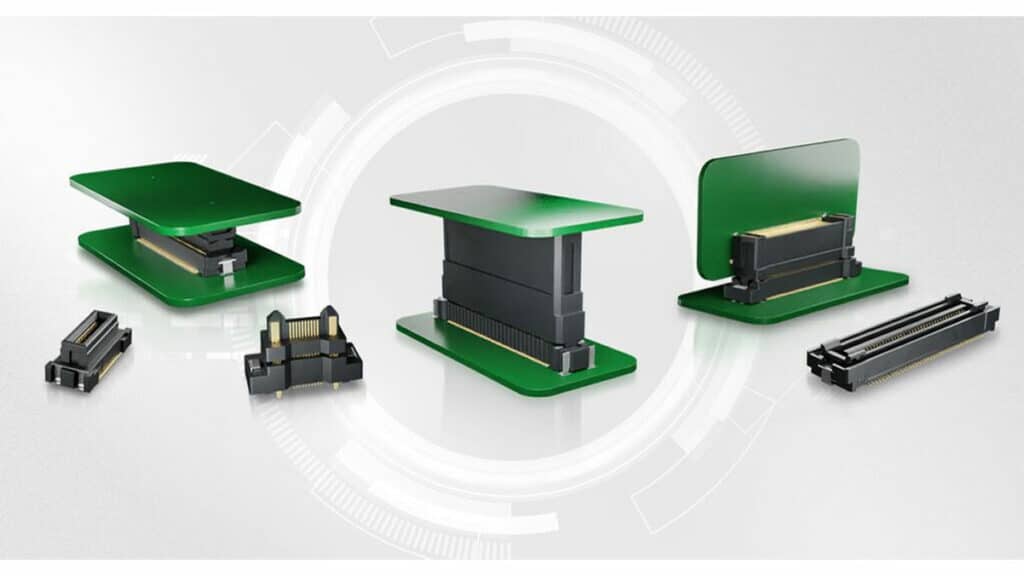Harwin releases Flecto, the new generataion of floating board to board connectors to support high-speed automated manufacture and long-term operational reliability.
Harwin has launched a range of board-to-board connectors that address the data and power transfer demands of high-performance applications while accommodating small movements in multiple axes to support high-speed automated assembly and enhance resistance to shock and vibration during operational life.
Offering up to 160 contacts in a symmetrical double row layout, the new Flecto floating connector family is available with three choices of miniature pitches: 0.5mm (.0197”), 0.635mm (.025”) and 0.8mm (0.0315”). By accommodating movement of up to ±0.5 mm in both the X and Y axes, Flecto allows for accurate placement of multiple connectors between the same two PCBs where the sum of misalignments might, otherwise, present challenges for high-speed, high-precision mating.
The positional tolerance flexibility of Flecto connectors also enhances system reliability by maintaining connection integrity during shock and vibration events and reducing the possibility of degradation or failure from ‘fretting’ – a situation that occurs when long-term vibration causes plating to wear from rigid mating pins, exposing the underlying alloy to potential oxidation.
“Growing demand for multiple connectors per board pair increases the potential for mechanical alignment issues due to the capabilities of automatic pick-and-place systems and the associated reflow process, which can cause connectors to experience unintended strain,” says Ryan Smart, Harwin’s Vice President of Product. “In addition, once systems are in the field, many connectors are subject to stresses resulting from short-term or long-term exposure to shock and vibration.
“Thanks to their innovative spring-like suspension mechanism, Harwin’s new Flecto family allows OEMs to address both these challenges with a comprehensive choice of fine-pitch, high-pin-count, high-performance board-to-board floating connectors for both data and power transfer.”
Flecto connectors support board-to-board mating heights as low as 7.2mm and data rates as high as 12Gbit/s. Additional power pins available with the 0.5mm pitch options are rated for currents up to 3A. Vertical and horizontal female connectors allow boards to be connected in parallel or at right angles to each other, while Flecto signal-only connectors feature either location pegs or posts to eliminate movement during solder reflow. On the mixed signal and power connectors, through-board solderable posts are provided for location accuracy and enhanced mechanical strength. A number of the connectors feature shrouded contacts to prevent accidental damage when no mating connector is present, while others offer polarization within the shroud to ensure uni-directional mating.
Target applications for the new range include factory automation, electric vehicles, LED displays, security cameras, IoT devices, data communications and a wide variety of embedded systems.
Modern electronic designs often incorporate multiple PCBs, whether as a way of decreasing design time by taking a modular approach or as a necessity to ensure the final solution fits the available space.
Clearly, there needs to be an effective way of connecting these boards to distribute signals and power. While several methods exist, the use of board-to-board connectors has become widely adopted, with the demands of modern systems meaning that often more than one connector is needed between PCBs.
Deploying multiple board-to-board connectors between a pair of boards necessitates very precise placement on the PCB, while the need for automated manufacturing demands placement at very high speeds. Unfortunately, with two or more connectors mating the same two PCBs, the level of placement accuracy may be outside the parameters of the manufacturing process. As even sub-millimeter misalignment can increase stress on the connectors, this is a problem with a potential to create quality, yield and field reliability issues.
Featuring spring-like terminals that allow them to move laterally and longitudinally and thus accommodate mis-alignment, ‘floating’ connectors provide an innovative solution to this problem. They can also contribute to improved connection integrity by absorbing shock or vibration during operational lifetime.
One of the most recent additions to the world of floating board-to-board connectors is Harwin Flecto range. This comprehensive family of connectors offers a number of innovative features that allow for multiple connections between a pair of PCBs without placement accuracy issues.
Available in all-signal or mixed signal and power options, Flecto offers a broad range of options for contact pitches and number of contacts per connector, with mated mounting heights as low as 5.98mm. Products in the family support both parallel and right-angle interconnects, while additional support for accurate alignment and robust interconnects includes location pegs that eliminate movement during solder reflow and retention tabs.
The connectors that mix signal and power also offer through-board solderable posts to augment both location accuracy and mechanical strength, enhancing resistance to shocks.
With the Flecto family of floating connectors, designers are free to deploy multiple connectors per board pair without worrying about manufacturing compatibility. This can bring a number of benefits to the design. For example, sensitive analog circuitry can be segregated from noisy digital signals (such as system clocks), while time-sensitive traces can be kept as short as possible to avoid introducing latency problems.
